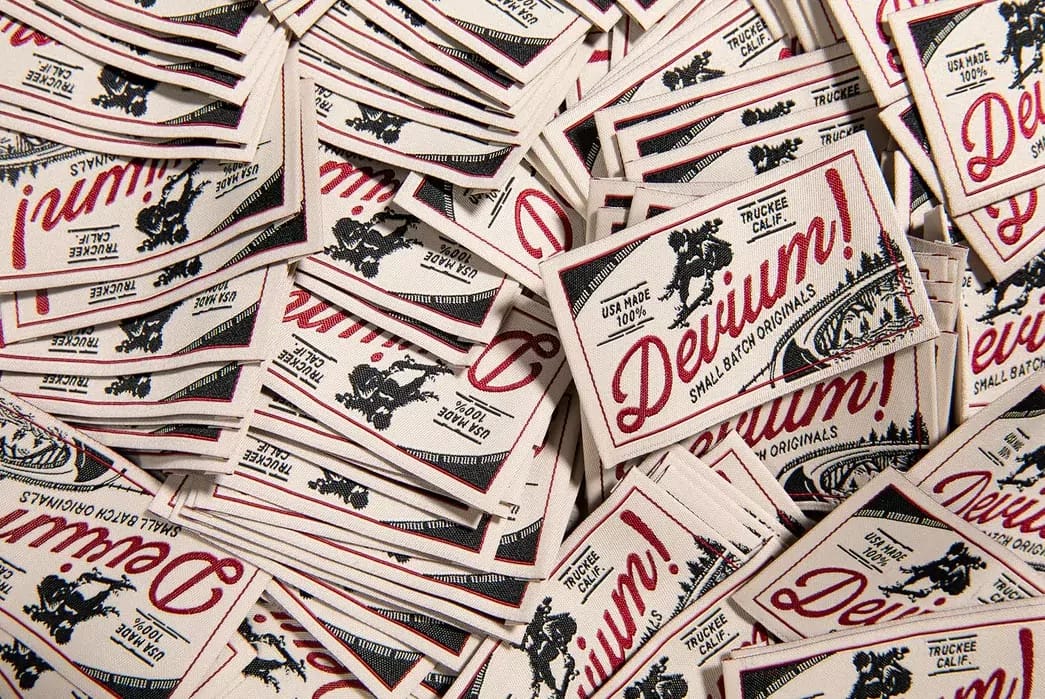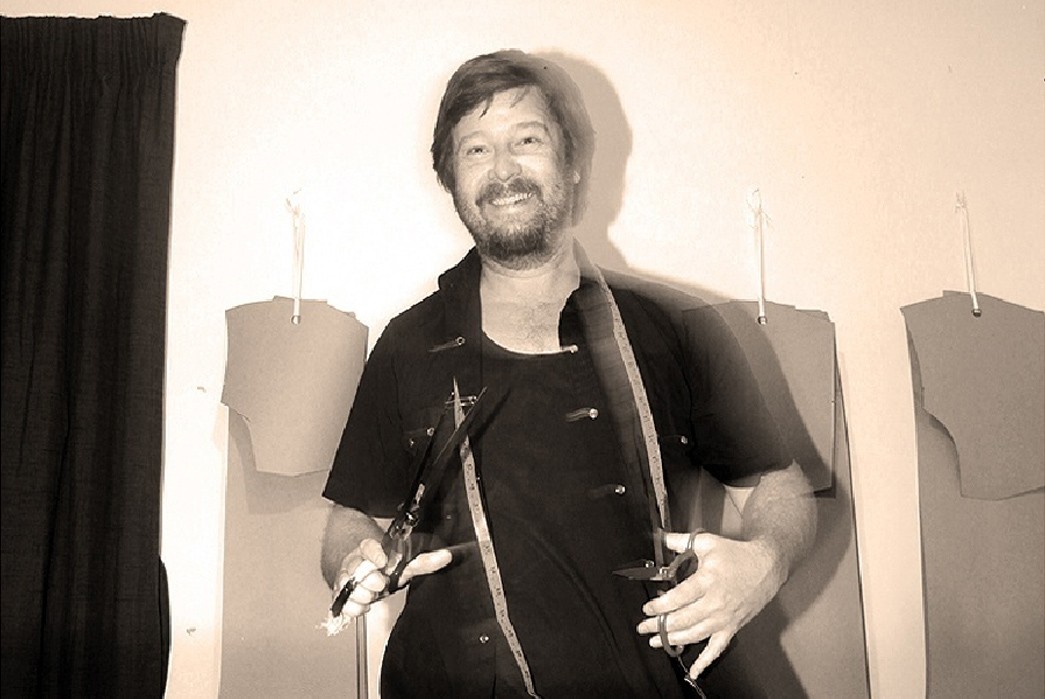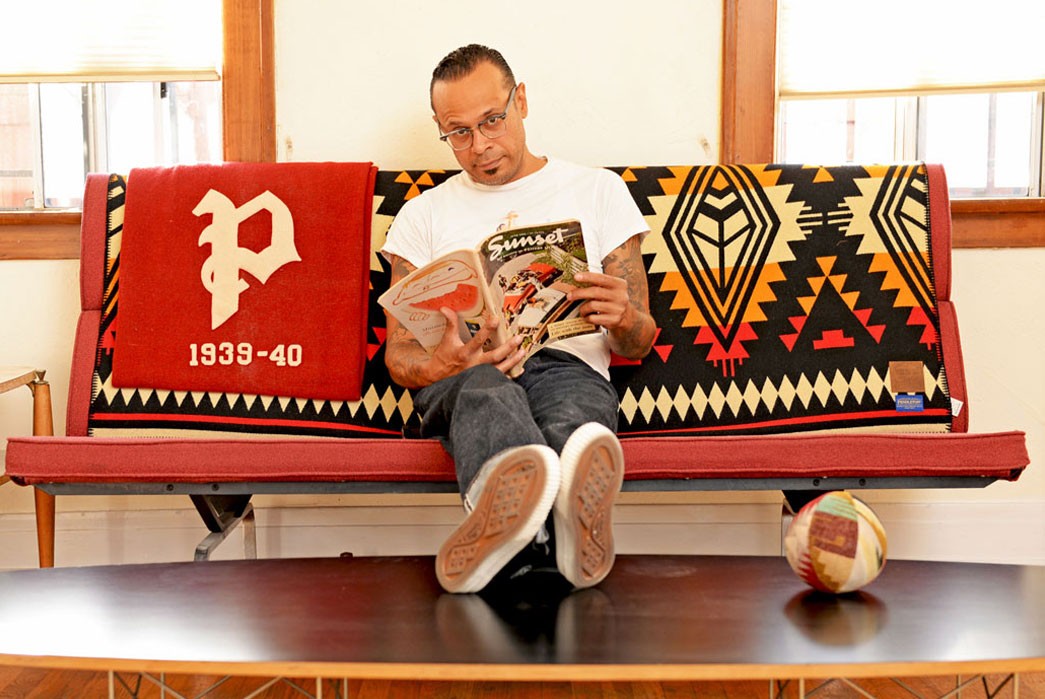- Heddels
- Posts
- How to Make (and Source) it in America with Devium’s Sheri Benjamin
How to Make (and Source) it in America with Devium’s Sheri Benjamin
How to Make (and Source) it in America with Devium’s Sheri Benjamin
Here from Devium, Wrangler, and Chief about all the delights and difficulties of making in USA in 2025
David Shuck

Made in USA goes much deeper than what you see on a label. It’s not as easy as just Googling “sewing factories near me” and entering your credit card for a hundred flannel shirts. There are people and histories every step of the way from where the cotton (or whatever other fiber) is grown, spun, knit or woven, dyed, cut and sewn, and trimmed into a finished garment.
As fewer big brands have chosen to produce in America in the last few decades, piecing this disparate web together to make a jacket or a sweatshirt (much less an entire collection season after season) has become a deeper and more esoteric process.
A self-educated master of this skill is Sheri Benjamin, one of the founders and self-described “Wrangler in Chief” at Devium, a brand on the cusp of its 10th anniversary that has made every stitch, zip, and sample in the United States. We had the chance to talk with Sheri about the current state of American manufacturing and some priceless advice for future designers who want to put their own name above a Made in USA label.
Heddels (David Shuck): How do you hear about new suppliers and production houses in the US? Is there a Yellow Pages for these sorts of things or is it just word of mouth?
Sheri Benjamin: It would be epic if there were some sort of manual for this. But there’s not.
I think American sourcing really clicked for us when we found SEAMS.org, which calls itself the Voice of the US Sewing Products Industry. From the very start, they were extremely welcoming to us, a tiny business with a big vision, and are always proactively trying to help us accomplish our mission of helping to rebuild the small business USA apparel supply chain – one American-made garment at a time. When we first joined the membership fee felt like such a reach for us, but after flying across America for my first conference of members, I walked away thinking that my membership would be more than worthwhile at triple the price.
AAPN (the Americas Apparel Producers’ Network) has also been an important resource for us. This association encompasses all of the Americas, but it also has a great contingent of USA manufacturers. Their executive director, Lynsey Jones, is an innovator and early adopter. They sponsor an annual North Carolina Mill Tour that really opened my eyes to the heritage and strength of Southern textile manufacturing. At every stop we made, there was someone on the mill’s executive team who always pulled me aside and said that even though we weren’t one of The Big Guys, they admired our mission, and would love to find a way to work together even though we were a small batch business.
Both SEAMS’ and AAPN’s members are Big Sharers – choosing to contribute their knowledge to the Made in the USA cause, instead of keeping their secrets close to the vest. I love being a part of that. There’s an amazing ecosystem of Made in the USA do-gooders out there.
You’re the only brand I’ve ever seen that shares the location of each vendor for each component of every garment. I certainly appreciate it, but why do you think that’s important for consumers to know?
Being transparent and specific about our apparel supply chain is the best way we know to show that we put our money where our mouth is, so to speak. We work hard to find these mills, converters, dye houses, metalworks shops, zipper manufacturers, fusing partners, sewing houses –even thread makers.
This past year or so has been all about getting these partnerships dialed in, and in this coming year, we hope to be able to more proactively showcase our partners and what they do so well.
What does it take to vet a new maker? Surveying the goods? Visiting the factory? Staring the owner in the eye?
Vetting a new partner, whether it’s a mill, or a trims maker, or a sewing house, always starts with the basics. And it always starts with an in-person eyeballing. My husband is in commercial real estate, and he uses the phrase “You gotta go to know” so often that it’s family lore. But it really does apply to Devium and how we vet and engage with our partners.
I always start with two questions: First, I ask “Tell me about your ideal clients?” and let them freeform from there. It seems like an overly broad question, but how they unpack that answer tells me what’s most important to them.
Then I ask them about what makes for a bad client for them. After the instinctual answer about companies paying their bills (it’s amazing how many in this industry don’t), the answers I get are largely about transparency, great communication, and promise-keeping–whether that promise is about the schedule, or the payments, or something else. Everyone wants a partnership that’s a beautiful two-way street. That’s what we strive for.
Next, I mentally check their Pride Meter:
Are they proud of their business and what it is today?
What’s the story of their business?
Will they show me their entire operation in a walk-through, or am I kept on a super tight leash of seeing only very specific areas of the business?
And just as important as their pride is their willingness to be vulnerable about things that they’re working on, or that aren’t perfect there. Give me a sewing house that tells me how they’ll fix stuff when best intentions go awry, rather than the one who promises to be all Mary Poppins – Practically Perfect in Every Way.
And last, I’ll check specifically on their manufacturing line for the types of equipment they’re using, and how experienced their teams seem to be at using those types of equipment. After all, a perfect flat felled seam is all about the right equipment AND the right craftsman.

Any red flags you look for?
There are oh-so-many:
I’ve learned to never show up anytime around lunch or I’ll miss the manufacturing line in action.
I observe how the teams are treated. With respect and like craftsmen or not so well?
I eyeball the equipment. Does the equipment look like it’s well taken care of? Some of the best equipment is actually old school equipment, so it’s not like I’m looking for new. I’m looking for that equipment to be treated like a member of the family!
Is there good communication going on up and down the line?
Do operators look happy to see me as I’m given the tour, or do they look fearful of management?
Is there attention to detail regarding the manufacturing process? Can they answer questions like how often needles get changed on sewing machines, or whether the buttonhole machine operator mainly works on buttonholes?
Is there an equal amount of crafting and analyzing going on at the same time?
We’re definitely belt-and-suspenders types when it comes to “papering” our expectations – so the perfect partner is also pretty buttoned up with at least following our paperwork, and agreed-upon timelines.
What are some signs of a good partner?
They have some sort of rubric they use with customers. They know the answer to “What makes for a customer that’s a good fit for you?” They’re also willing to answer the question “What kinds of customers do NOT work for you?”
They’re craftsmen with amazing attention to detail, even, or especially, at the top.
They always say what’s on their mind. Even if it’s a little uncomfortable to say it out loud. Get it all out on the table.
Owner operated.
I will take a family owned, legacy business over almost anything else. I’m a business romantic that way.

How does one communicate with a manufacturing partner? Is there a standardized tech pack or form across the industry?
That depends. Some of our legacy, super small, rather bespoke partners work The Old Fashioned Way. In-person visits. Phone calls and emails. Texts are kind of a stretch.
For example, our current metalworks partner (think grommets, snaps, metal shanks, and such) is very Midwestern and definitely Old School. No website. I found them by channeling my inner Nancy Drew – lots of footwork and tenacity. They’re a second-generation 60-year-old business and think of themselves as a metalwork shop, not as an apparel trims manufacturer. And while they used to do more apparel trims 40 years ago, they shifted away from apparel during the shift to Asian manufacturing. Right now we’re the only customer that does this type of work with them.
Other partners are more sophisticated and definitely identify with being in the apparel business. They’re early adopters (at least as it pertains to apparel manufacturing). For communications with these folks, we use Slack, text and an occasional phone call. And I’ll always reserve the right to show up unannounced. These types of partners were founded usually by a single owner with a passion for their craft. Whether that means that they’re up for buying the newest and coolest machines, or that they’re just steeped in the love of the apparel industry, and can’t imagine working anywhere else.
There’s no standardized way to do this. Some people need 30 emails to get things done, while others just need a 30-second phone call. I’ve got manufacturers who have me on speed dial, and if they call at 7 PM, I know it’s urgent, and I pick up no matter what.

How many vendors has Devium worked with to date? How many do you work with currently?
I actually compiled a spreadsheet to track all of our vendors, and I should have a final number soon. As I go through our past collaborations, I’m realizing the number is bigger than I initially thought. I’ve been checking our bills of materials per style, and each piece we’ve made has involved multiple partners. It’s been an interesting process to look back on, especially when I found an old first-generation Devium sweatshirt in my closet—horrifying and gratifying at the same time. We’ve come a long way since then.
The final answer—38 total partners (working with currently), from the east coast of Florida and North Carolina and Maine, through the midwest’s Missouri and Ohio, all the way to our left coast — California. Many of these are multigenerational family businesses, and the oldest company was founded in 1838 — 187 years old!
I might have missed a couple, but here’s the breakdown:
8 fabric mills (wovens, knits, fusing, narrow fabrics)
5 sewing houses
4 dye houses
3 embroidery houses
3 screen print companies
2 wash houses
2 zipper fabricators
2 snaps/metal buttons/grommet fabricators
2 button makers
2 custom label houses
1 custom quilting house
1 custom shoemaker
1 custom sock maker
1 custom beanie maker
1 thread manufacturer
How many samples does it typically take before something is ready to send into production? What’s the most number of samples you’ve ever done of something?
One of the great things about producing in the U.S. is that we can move quickly. Unlike working with factories overseas, where sample rounds take forever due to shipping delays, I can get things done efficiently.
For some products, we get it right the first time—our fit model, Zac, will try something on and say, “Just add a quarter inch for shrinkage, and it’s good to go.” Other times, it takes a few rounds. On average, we go through about three to four samples before production. That’s the most we’ve ever needed.
A big part of this is working with people who know what they’re doing. Zac has an incredible sense of fit, and he can speak directly with our pattern maker, Elizabeth, to make small, precise adjustments. They have their own secret language when it comes to perfecting a garment. I just sit there, take notes, and let the magic happen.

What does the U.S. currently produce really well? What could we improve on?
The U.S. is great at producing knits—things like fleece, French terry, and cotton tees. There are a lot of strong knit mills, particularly in North Carolina. We work with a second-generation knit mill where the owner took over from his father, and they’ve perfected their craft. Plus, most U.S. knit mills use domestically grown cotton, which makes transparency and traceability much easier. I love being able to say, “This fabric came from a North Carolina cotton field.”
On the other hand, woven fabrics are a challenge. There aren’t many mills making high-quality woven textiles, especially for lightweight summer fabrics. That’s why Devium leans more into fall and winter apparel—it’s just easier to source the right materials. If I could change one thing about American manufacturing, it would be expanding woven fabric production.
What’s the number one thing you would tell someone who’s trying to make clothing in the U.S.?
Stay humble, ask questions, and don’t assume anything.
One of the biggest mistakes I made early on was assuming that every manufacturer would naturally prioritize high-quality construction. That’s not the case. If you don’t clearly communicate what you want, you might get something rushed and cheaply made. I once received a terrible sample because I hadn’t specified my expectations, and the manufacturer assumed I just wanted the cheapest option.
Also, be in it for the long haul. Devium is a small family business with a big mission, and it isn’t for the faint of heart. My Co-founder and Favorite Son (and only son!) Cody Benjamin and I joke that we should’ve probably just started Devium as a nonprofit, because the cause is pretty expensive and sometimes you can’t fulfill the mission and be anywhere nearly as profitable as you need to be. You need to truly believe in what you’re doing because this industry isn’t easy, and you’ll face challenges at every turn.

Anything else to share?
We’re working on some exciting new products! Right now, we’re about to release a flannel jacket with quilted lining—the kind of jacket you wear every day until it finally falls apart. Our Boca Flannels have been really popular, and this is the next evolution of that. They just landed in our warehouse, and we’ll be shipping them out this week.
Beyond that, I’m working with my team to update our digital ads, making sure they reflect the right seasonal products. Sometimes we forget that while it’s warming up in California, it’s still freezing in other parts of the country!
I also feel like Made in the USA is gaining momentum. More people are realizing that it’s important, and my job this year is to help them understand why it costs more—and why it’s worth it. It’s not just about saying, “Support American manufacturing”; it’s about educating people on the value behind it.
At the end of the day, I know we’ll never compete with Old Navy or Costco prices. And that’s okay. We’re not trying to. If someone doesn’t see the value in well-made, ethical clothing, they’re probably not our customer. But for those who do? We’re here for them.
You can learn more about Devium and peruse their entirely made in USA collection on their website
Like this? Read these:
What did you think of today's newsletter? |

